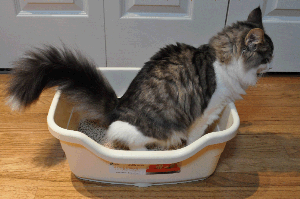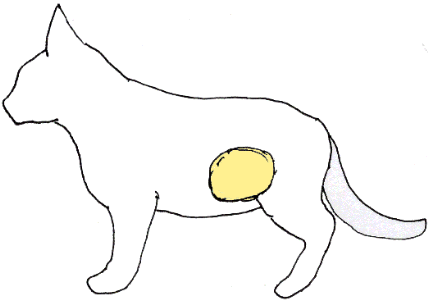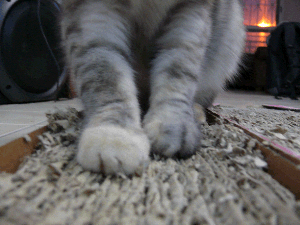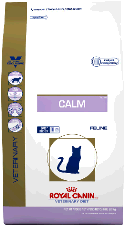|
FELINE IDIOPATHIC CYSTITIS

(Also known as "Pandora Syndrome" and formerly known as "FUS")

(original graphic by marvistavet.com)
FIRST, SOME TERMINOLOGY (FIC, FLUTD, FUS, UTI and how they all fit together)
For a long time these abbreviations were used interchangeably but they really shouldn't have been because they refer to different conditions. Let's start with Feline Lower Urinary Tract Disease (also called FLUTD). The urinary bladder and urethra are the lower urinary tract and when the lower urinary tract is diseased from ANY cause, the symptoms are the same.
- bloody urine.
- straining to urinate (can easily be mistaken for straining to defecate.)
- urinating in unusual places.
- urinary blockage (almost exclusively a male cat problem and constitutes an emergency.)
- licking the urinary opening (usually due to pain).
The symptoms above could be from ANY cause: bladder tumor, UTI (urinary tract infection), bladder stone, etc. Basically any source of inflammation in the bladder will create FLUTD. We used to use the term FUS (which stands for Feline Urinary Syndrome) to describe FLUTD and you may hear or read the term FUS somewhere so we are bringing it up but it was decided that FLUTD was more accurate so that is what we say now.
WHAT ABOUT FIC?
Feline Idiopathic Cystitis (FIC for short) is a common cause of FLUTD in younger cats. So what is Feline Idiopathic Cystitis? It turns out to be a defect in the way a cat handles stress. An easy analogy is the human who gets a recurring upset stomach from stress. Similarly, cats get a recurring upset bladder from stress. Not every cat is susceptible to FIC; some cats are simply neurologically wired to have issues with how they handle stress.
HOW DOES STRESS INFLAME THE BLADDER?
|

(original graphic by marvistavet.com)
|
The urinary bladder is lined with special glycoproteins called PSGAG’s. This material basically insulates the tissue of the bladder from the urine it contains. Urine can vary greatly in pH and can contain abrasive crystals in addition to assorted toxins and irritants that the kidneys have removed from the bloodstream and concentrated. All of these unpleasant materials are present in urine so it is a good thing to have a layer of insulation protecting the actual tissue of the urinary bladder.
If the lining of the bladder becomes patchy, the tissue of the bladder is directly exposed to the urine and inflammation results. The bladder PSGAG layer becomes patchy when the cat is experiencing anxiety. For decades, management of FIC focused on reducing urinary crystals, changing urinary pH, and improving the PSGAG layer of the bladder. What seems to be the most effective approach is addressing the stress that caused the problem in the first place but even doing this is a preventive measure. Dealing with active an episode of FIC is another matter entirely.
|
THE ACTIVE FIC EPISODE: DIAGNOSIS AND TREATMENT
|
When a young adult cat is presented with FLUTD symptoms, some effort is made to rule out more specific causes such as bladder stone and bladder infection. These conditons have specific approaches and can be ruled in or out by tests. There is no test for FIC. The diagnosis of FIC is based on negative tests for other more definable conditions and the clinical picture of the patient (young adult cat, recent stress in history, anxious temperament, past history of similar symptoms etc.). Most young adult cats with FLUTD symptoms are believed to have FIC.
An episode of FIC typically lasts 1-2 weeks. Despite decades or research on this condition, no treatment has emerged that will shorten the duration of the episode. All we can do is manage the pain and urinary discomfort until the episode passes.
|

(Photocredit: Ocdp via Wikimedia Commons) |
ANTI-SPASMODICS AND TRANQUILIZERS: These medications help the painful urethral spasms that occur with the inflammation associated with the episode. They also help the urethra dilate so that urine can pass. Typical medications might include: acepromazine, phenoxybenzamine, or prazosin.
ANALGESICS: These medications may be straight pain-relievers with no anti-inflammatory effects or actual anti-inflammatory pain relievers. Typical medications might include the fentanyl patch, buprenorphine, tramadol, robenacoxib, or others. FIC is very painful and proper pain relief is crucial.
Unfortunately, FIC is a condition where we are much better at preventing future episodes than we are at treating an active episode but before we go on to prevention, we need to review one more acute and very serious FIC Complication: urinary blockage.
|
THE BLOCKED MALE CAT: AN EMERGENCY SITUATION
The male cat urethra is extremely narrow and not equipped to handle mixtures of normal urinary crystals and increased mucus secretion from inflammation. The crystals and mucus combine into an actual plug and can block the male cat's urinary tract. If urine cannot pass, toxins build up and death occurs in a matter of days.
If the cat develops a full or partial urinary obstruction during the episode, THIS IS AN EMERGENCY and the obstruction must be relieved at once. If dangerous urinary toxins have built up, intravenous fluid therapy will be needed to reverse the life-threatening situation. This is almost exclusively a male cat situation. For more information on this complication of FIC, click here.
|

Location of urinary bladder is shown in yellow. A blocked
bladder feels hard and of similar size to what is shown here.
(Original graphic by marvistavet.com) |
WHY DO ONLY SOME CATS GET FIC?
We know that cats that get this syndrome have a unique imbalance in the way their brain controls stress hormones. . These cats are neurologically different in a way that makes them extra reactive to any change in their world, extra anxious, and extra sensitive to pain relating to the back half of their bodies. They are different from other cats but as long as they live in a predictable environment with the same food, same schedule, private food, rest and toilet resources etc. you might never know you had a sensitive feline in the family. Typical or common triggers for FIC might include:
- Stress among the humans in the home (final exams, arguments, sickness etc)
- Someone (or another animal) moving in or out
- Construction in the home or outdoors
- Weather change or earthquake
- New furniture
- Moving to a new home
- Changing to a new brand of food
- Humans changing schedules as to when they are home
FIC cats are very sensitive and urinary signs can flare up over events that humans frequently discount or pay no attention to. Most pet owners, however, are aware that the cat in question has a personality that is somewhat anxious or sensitive.
PREVENTION OF FUTURE EPISODES
Environmental Enrichment
| Many people are surprised to find that environmental enrichment is effective in preventing future FIC episodes. One might think their cat has plenty of toys and seems relaxed and well-adjusted but reality is that the cat's natural environment of living in the forest and hunting/eating mice regularly throughout the day is a far cry from sitting on a sofa, eating processed foods, and eliminating waste in a plastic box filled with clay. Most cats are fine with the domestic lifestyle but the FIC cat is special and has special sensitivity. Stress can be minimized by allowing choices for the cat in terms of where he/she can play, rest, eat, eliminate. Just providing more toys is unlikely to be adequate. Most of the time the cat in question needs a private area for "me time" (separate feeding, rest, and/or toileting area). |
 (Photocredit: Arria Belli via wikimedia commons) (Photocredit: Arria Belli via wikimedia commons) |
The American Association of Feline Practitioners has published a set of guidelines for an enriched feline environment. The guidelines can be viewed at:
http://www.catvets.com/guidelines/practice-guidelines/environmental-needs-guidelines
but here is a summary:
- Each cat at home should have the opportunity to play with the owner or with another cat if he/she chooses to.
- Each cat should be able to move freely about its home including climbing if he/she chooses to.
- Each cat should have convenient access to a private rest area where other animals will not disturb him/her or an escape route should he/she be bothered. There should be no loud appliances in the rest area that might suddenly come on and be frightening.
- Scratching posts should be available.
- Toys should be regularly rotated/replaced.
- Each cat should be able to choose warmer and cooler areas within the home.
- There should be a litter box for each cat, ideally plus one extra. Litter boxes should be located in well-ventilated areas and should be kept clean. Boxes should be washed out weekly with a minimally scented detergent. Unscented clumping litter seems to be best. If there is more than one floor in the home, there should be a box on each floor. Litter boxes should be private enough that other animals will not be bothering the cat and loud appliances will not startle the cat during litter box use.
- Each cat should have his/her own food and water bowls. Feeding/watering stations should be safe so that other animals (like dogs) will not be startling the cat. Bowls should be washed daily.
- The brand, flavor, or format of the food (dry vs canned) should be kept fairly constant. If it is changed, allow the cat a choice of new food vs. old food at least for a while before changing over and do not change more than once a month.
Another excellent resource is the Indoor Pet Initiative sponsored by the Ohio State University: https://indoorpet.osu.edu/cats
Canned Food and Urinary Formulas
|
For decades, FIC was felt to be dietary in origin. In fact, when feline commercial foods were reformulated in the 1980's to create a more acid urinary pH, the incidence of feline cystitis dropped spectacularly. Urinary crystals (usually struvite) are very important in the male cat syndrome of urinary obstruction which is a complication of FIC and scientific studies have found benefit to using urinary diets to prevent future FIC episodes.
Studies seem to indicate that canned urinary formulas are more successful than dry. The increased water content of canned food is usually credited for this but it has also been proposed that it is the aroma/sight/sound presentation and owner interaction involved in feeding canned that makes the difference. Still, increasing water consumption is frequently recommended decrease future episodes of FIC.
|
 |
 |
 |
Some cats may benefit from medication and/or supplements for anxiety. For more details on these, see our House-Soiling information page.
WHAT IF MY CAT DOESN'T SEEM TO BE ANXIOUS?
If your cat does not seem to fit the picture or there has been no obvious stressor at home, keep in mind the FIC diagnosis is "exclusionary" which means other tests are negative. Be sure diagnostics have not been skipped (urinalysis, ultrasound of the bladder etc.). FIC is the most common diagnosis in younger cats with lower urinary symptoms but it is best not to "play the odds" and miss a bladder infection or stone.
It is worth mentioning again that male cats with FIC can develop a life-threatening obstruction which is an emergency.
If you have a cat who is straining in the litter box, urinating in unusual places or demonstrating any of the signs
listed at the top of this page, be sure to schedule an appointment with your veterinarian promptly.


Page last updated: 10/30/2024
|